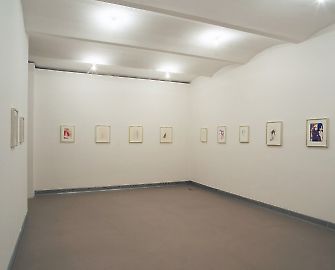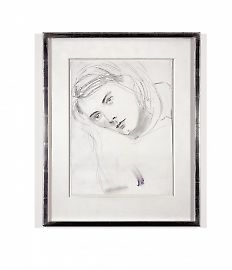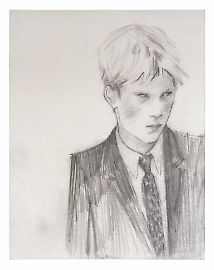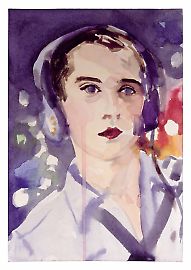Elizabeth Peyton --
[…] “I read Melody Maker like Marcel Proust.” This is how the young American painter Elizabeth Peyton describes one binary dualism that structures her work. […] High and low take place concurrently; the artifacts are appropriate to the taste of the reader of pop music fanzines as well as the demands of the “art connoisseur.” But Peyton’s works differ from Pop Art in their high degree of emotionality. […] With her brush, Elizabeth Peyton expertly takes this double strategy to the limit: she arranges in a painterly way and with a well-tempered colorful gloss newspaper photographs of Jarvis Cocker, the singer of the Brit-pop band Pulp, to form her own intimate portrait Jarvis, and the artist colleague Piotr, Uklanski poses for the painter wearing a “bad taste”-brand red shirt. High and low are here placed on an equal footing, just as are mediated familiarity or face-to-face contact: there is no positive or negative valuation of one or the other. Historical figures like, Ludwig, (van Beethoven) or Napoleon’s lover, Mademoiselle George, are immortalized in the artist’s gallery of ancestors. As Peyton knows, the history of star worship is older than that of Hollywood. […]
Peyton identifies herself in her painterly interpretation to such an extent that she enters into a closed circuit with her idols: on a formal level by usually making images of images, and on a thematic level in that her own search and the visionary search of the person depicted are short circuited with one another. In this way public icons are in a sense privatized, in that even select elements of old and new media realities are actively interpreted as semantic fields. Now resemanticized, they then take on an “individual,” utopian quality. Peyton’s portraits are thus always also self-portraits, another binary code of her work. Thanks to this, Peyton is able to break out of a self-satisfied, autistic world. […]
The fact that visionary worlds––and this includes also the “Operation System” art––are self-referential and closed(1) systems is in part a result of the borderless marketing strategies of capital: pop music, just like art, is always part of the market, but it is also its contradiction. It is affirmation and utopia at the same time. Only in the “local” (J. Fiske), in the inner circle of (private) life, does utopia seem to come to fulfillment at fleeting moments. This idyll, which often represents itself as a negative, cynical, no-fun paradise, is often threatened by commercial marketing and external repressive pressure: this can be read off the life of Kurt Cobain, a pop figure also portrayed by Peyton. The singer of the grunge band Nirvana committed suicide in 1994, caught in a vicious cycle of fame and disillusionment […] This dualism of “death and glory,” of latent sadness and bursts of hope lend Elizabeth Peyton’s portraits their typical appearance. […] She thus always brings problematic figures with a vision before her interpreting eye: the gallerist, the pop singer, the young successor to the throne, the artist.
(1) The legendary “personality” has always been described as a closed system: as a rule, geniuses are lonely, misunderstood, and not in search of understanding; they are self-sufficient. In brief: a universe all their own.
Raimar Stange, "A Star Was Born. Zu den Porträts von Elizabeth Peyton," in: Kunstbulletin (November 1996), pp. 18 -23.








